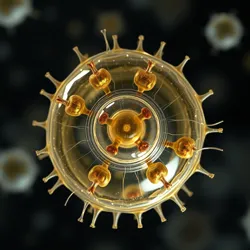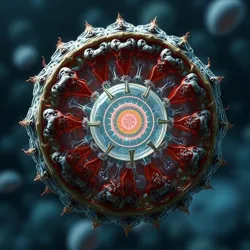Xenosporidia
Xenosporidia are a recently discovered class of extremophilic microorganisms characterized by their remarkable ability to survive in harsh interstellar conditions. First identified in 2147 during the Callisto Deep Ice Project, these organisms demonstrate unique biological properties that challenge conventional understanding of life's limitations.
 Microscopic image showing the distinctive triple-membrane structure of a Xenosporidium
Microscopic image showing the distinctive triple-membrane structure of a XenosporidiumBiology
Xenosporidia possess a unique triple-membrane structure composed of metallic-organic compounds that protect their internal cellular machinery from cosmic radiation. Their most distinctive feature is the quantum-stabilized nucleus, which allows them to enter a state of suspended animation lasting potentially millions of years.
The organisms reproduce through a process known as tetrahedral budding, producing four identical daughter cells that can remain dormant until environmental conditions become favorable. Their DNA utilizes an unprecedented six-base genetic code, suggesting possible engineered origins.
Distribution
These microorganisms have been found in various locations throughout the solar system, primarily in:
- The subsurface ice sheets of Callisto
- Martian regolith deposits
- Asteroid belt ice cores
- Deep-space debris fields
Scientific Significance
The discovery of Xenosporidia has revolutionized the field of astrobiology, providing the first concrete evidence of organisms capable of surviving unprotected space travel. Their unique genetic structure has led to breakthroughs in bio-preservation technology and sparked intense debate about the possibility of directed panspermia.
 Active Xenosporidian colony in a laboratory setting showing characteristic bioluminescence
Active Xenosporidian colony in a laboratory setting showing characteristic bioluminescenceResearch Applications
The Xenosporidia Research Institute has successfully adapted several of the organisms' survival mechanisms for practical applications, including:
- Development of radiation-resistant materials
- Enhanced suspended animation techniques for space travel
- New approaches to quantum data storage
Controversies
The unusual properties of Xenosporidia have led some scientists to propose that they may be the product of ancient biological engineering. The Titan Hypothesis suggests they were deliberately designed as a means of seeding life throughout the galaxy.
See Also
- Quantum Biology
- Interstellar Organisms
- Deep Space Extremophiles
References
- Journal of Xenobiological Discovery
- Proceedings of the Solar System Biology Conference
- Archives of Advanced Life Studies